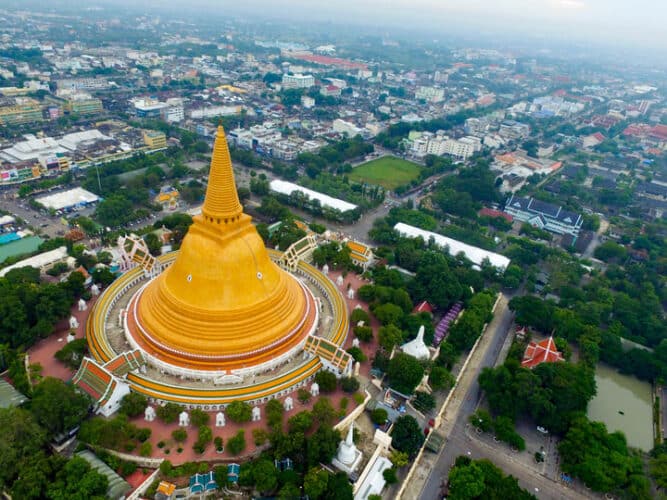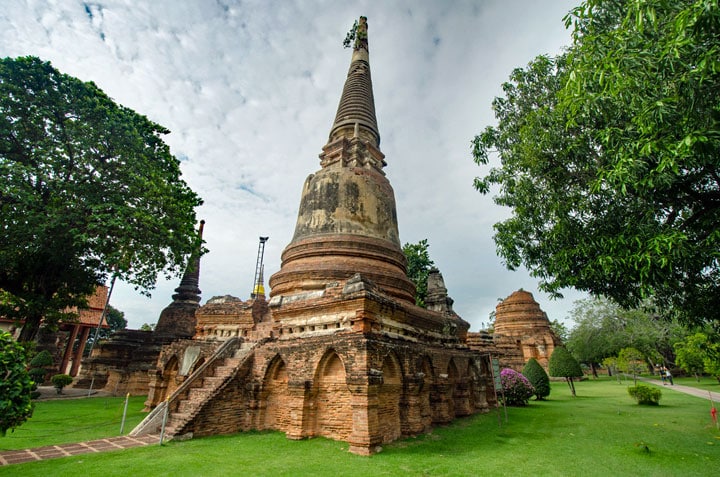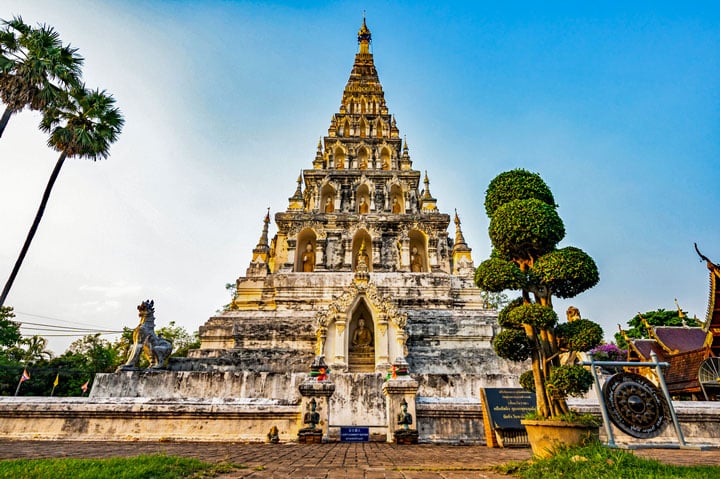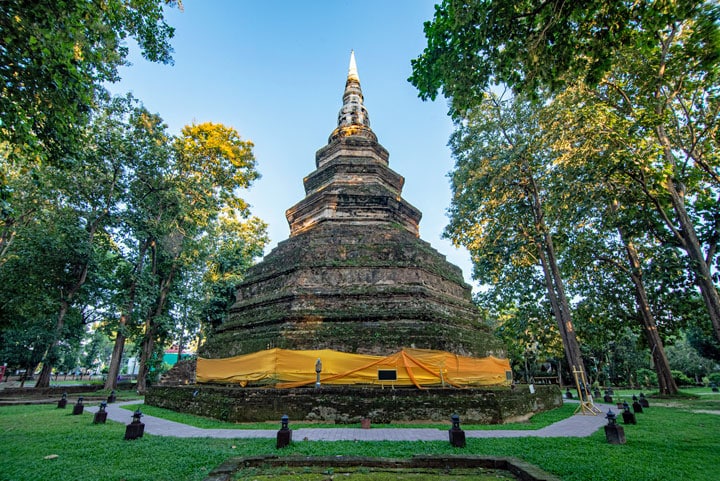Don't just say stupa to a chedi

Wat Phra Pathom Chedi
You simply cannot miss it in Thailand; the chedis, the local variant of what is known in the rest of the world - with the exception of Tibet (chorten), Sri Lanka (dagaba) or Indonesia (candi), as the stupas, the round structures containing Buddhist relics or, as in some cases also the cremated remains of the Great Ones of the Land and their relatives.
The stupas or chedis may have arisen from the tumuli, round burial mounds that were erected in ancient times in India over the cremated remains of eremits or hermits. These domed tombs, often built on top of a square terrace, were considered sacred places and were often the center of worship.
After the death of Siddhartha Gautama Buddha, according to tradition, about 370 years before our era, his ashes and other relics directly linked to him were interred in chedis. This was obvious at first sight, but apparently there were many called and few chosen to receive part of his remains. It was close to a civil war breaking out over the possession of these relics, but the wise Brahmin Drona managed to prevent this in the nick of time by allocating them in equal amounts in - according to traditional tradition - 8, 10 or 11 parts. Some time later, the Indian Buddhist ruler Asoka (304-232 BC) is said to have had all these remains excavated and reunited to place them in 84.000 chedis all over the world in one day. It has been this legend in particular that has fostered the cult and veneration of the relics of the historical Buddha in Central, East and Southeast Asia. From Sri Lanka, Sukhothai and Luang Prabang to the furthest reaches of China, we find chedis that are said to have originated in the distribution of relics by Asoka.

Wat Yai Chai Mongkhon in Ayutthaya
In fact, there were two main reasons why chedis were erected after the death of the Buddha. On the one hand, they wanted to preserve their relics in this way, and on the other hand, it was thought that this was an appropriate way to commemorate the eight great deeds that the Buddha had performed during his life. According to a beautiful legend, Buddha, when he felt his end approaching, showed his disciples in a very simple way how he imagined the shape of his tomb. He folded his monk's robe in half, laid it on the ground and placed his inverted begging bowl and his monk's staff on it in succession. With this he indicated the three main components that make up a chedi: a square stepped foot or base surmounted by a domed or bell-shaped body, topped by a pinnacle, a slender, tower-shaped crown usually ending in a spire. Over time, hundreds of variants of the chedi emerged, but almost everywhere these three basic elements remained the core of these monuments.
Building a chedi is accompanied by a number of rituals that start immediately with the determination of the most suitable location up to and including the initiation. Of course, these rituals do not just take place and especially emphasize the great spiritual importance that is attached to these structures to this day. After all, the chedi is the symbol of how nirvana ultimately triumphs over the cycle of rebirths, but at the same time the chedi also figures as a representation of the sacred mountain Meru, the abode of the god Shiva who maintains the universe and who forms the connection between heaven and earth.

Wat Chedi Liem in Wiang Kum Kam – Chiang Mai (KobchaiMa / Shutterstock.com)
In addition, the five elements of nature are depicted in its construction and the traditional parts of the structure and how they relate to an enlightened mind. The base, for example, symbolizes the earth, but also equanimity. The dome stands for water and indestructibility, the base of the spire for fire and compassion, the spire for the wind and self-fulfillment and the top for space, the celestial spheres and the clarified and expanded consciousness. Others argue that the round shape of the chedi refers to the body shape of the seated, meditating Buddha and that the structure also represents the spiritual presence of the Buddha and/or his disciples. From this symbolic approach, it should therefore come as no surprise that the chedis also form the sacred centers of the buddhavasa, the part of a monastery complex reserved for the worship of both monks and laymen.
Many monasteries were therefore built around the chedis and not the other way around, as many tourist guides erroneously claim. A bizarre detail in the eyes of many foreigners is that chedis, as an embodiment of the Buddha, have legal personality and can therefore assert legal rights. Gifts given to a chedi remain the property of that specific chedi and not of the sangha, the Buddhist community. From this perspective it is also understandable that there are high penalties for anyone who damages or destroys a chedi. Precisely because chedis can be regarded as incarnations of the Buddha, they are considered sacred at all times. A whole cult arose around it, which contains numerous rules ranging from provisions on how to pay respects to the prohibition to point one's feet in the direction of a chedi to the obligation to walk clockwise around a chedi. It goes without saying that it is also forbidden to climb a chedi, not even to make an offering…

Chedi Luang Chiang saen (ChiangRai)
Originally, the relics – often in precious metal containers or decorated with precious stones – were interred in the so-called harmika, the square base of the pinnacle on top of the convex or bell-shaped main body of the chedi. When this repository proved to be unsafe and vulnerable to long fingers, relics and other valuables began to be buried in small compartments deep beneath the chedis. A practice that had also not gone unnoticed by Jeremias van Vliet (ca. 1602-1663), the particularly observant VOC chief merchant in Ayutthaya:
"Besides that, under the seats of the idols in some tempems great treasures of gold and silver were buried, also many rubies, precious stones, and the other jewels in the highest tops of some towers and pyramids, which for the service of the Good remain there eternally. Fabulous histories among the Siammers were told of the multitude of these treasures.”
In addition to the chedi, which borrowed its structure and shape per se from ancient India and was later influenced by Sri Lanka, a more tower-like sacred monument called Phra Prag, for which the Siamese have taken the mustard from the Khmer constructions. The tallest chedi in the world is the just under 130 meters high Wat Phra Pathom Chedi in Nakhom Pathom. It is also one of the oldest known locations of a chedi in Thailand, because this structure already appears in a chronicle from 675, but from archaeological finds it can be concluded that this place was already a religious site in the fourth century of our era. In the eleventh century, when the Khmer ruled the wider region, this chedi was considerably enlarged, but the current one was built on the initiative of King Mongkut (1804-1868). However, he would not live to see his consecration as he died two years before its final completion in 1870.


Nice story as we are used to from Lung Jan. Always fun to read.
Thank you and keep it up!
The properties and proper constructional proportions of Phra Chedis were investigated by Karl Doehring and are described in his seminal work:
Buddhist Stupa (Phra Chedi) Architecture of Thailand
https://www.whitelotusbooks.com/books/buddhist-stupa-phra-chedi-architecture-of-thailand
Relics also often remind me of Western Christianity, and in particular of the Holy Foreskin of Jesus. Jewish tradition teaches that it must be buried, but about twenty churches in Europe claim to possess these relics, which are mainly venerated by nuns. There were fierce debates at the time as to whether Jesus had ascended into heaven with or without a porch and what it would be like at His Second Coming. A few paintings of a naked Jesus did not give a clear answer. Without religion no chedis, temples or churches! We must remain grateful to our ancestors.
The word 'stupa', of course, comes from Sanskrit and means 'heap, pile'.